Physical Address
304 North Cardinal St.
Dorchester Center, MA 02124
Saliva is produced by salivary glands in a range of animal species and fulfills many different functions. Of particular importance are its roles in nutrition, facilitating the chewing, tasting, digestion, and swallowing of food. Striking dietary related adaptations in salivary gland structure and physiology are seen in mammals, reptiles, and invertebrates. For example, the production of venom in order to immobilize prey has evolved in different species of gastropod, mammal, and reptiles while female anopheles mosquitos ( Anopheles albimanus ) produce a saliva containing anophelin, a thrombin inhibiting anticoagulant similar to anticoagulants produced by snake venom glands. There is an immediate, increased demand for saliva in relation to food consumption, mediated by sensory stimulation, and a nerve-mediated reflex. Large volumes of saliva are secreted by sheep salivary glands and enter the rumen in order to facilitate digestion and fermentation of a cellulose-rich diet while the giraffe produces richly mucinous saliva that lubricates and facilitates the consumption of a diet rich in leaves of acacia thorn trees. The paired major salivary glands, parotid (PG), submandibular (SMG), and sublingual (SLG), can increase their production of saliva in response to stimulation.
Apart from the immediate needs relating to diet saliva coats the surfaces of the mouth, providing a protective, lubricious layer that maintains homeostasis of the oral environment. Major reductions in levels of saliva in the mouth are therefore associated with oral and systemic disease and can impact severely on quality of life. The oral environment is a balanced ecosystem in which communities of microorganisms (microbiome) form biofilms on saliva-coated surfaces. In addition to the major salivary glands hundreds of small, minor submucosal salivary glands, exocrine glands similar to those underlying other mucosal epithelia in the upper respiratory and gastrointestinal tracts play an important role in fluid film formation on oral mucosal surfaces. Although its contribution to whole mouth saliva is < 10% by volume, saliva from minor salivary glands is a lubricant for the oral mucosa, owing to its high mucin content.
Salivary glands in humans and other mammals can be classified according to size into three paired major glands, PG, SMG, and SLG, which contribute to 90% or more of whole mouth saliva and variable number of glands (600–1000 in humans) forming minor structures located in the labial, palatine, buccal, lingual, and sublingual submucosae.
Major salivary glands consist of branching ductal trees terminating in secretory units referred to as acini; saliva formed by acinar cells is conducted through the ductal tree to be delivered to the oral cavity. In clinical investigations, this arrangement is well demonstrated by sialography when X-ray contrast medium is introduced retrogradely into the ductal tree ( Fig. 37.1 ). The paired PGs are the largest of the human salivary glands, weighing approximately 15–30 g and located in the preauricular region and along the posterior surface of the mandible ( Fig. 37.1 ). Each PG is divided by the facial nerve into a superficial lobe, lateral to the facial nerve, and overlying the lateral surface of the masseter and a deep lobe medial to the facial nerve and located between the mastoid process of the temporal bone and the ramus of the mandible. An accessory PG that may contain mucinous acinar cells in addition to the serous acinar cells can be found lying anteriorly over the masseter muscle between the parotid duct and zygoma. Its duct empties directly into the parotid duct through one tributary. The parotid duct, also known as Stensen’s duct emerges from the anterior border of the gland, travels anteriorly parallel to the zygoma, until it turns abruptly towards the buccinator muscle, piercing it and entering the oral cavity opposite the second upper molar tooth.
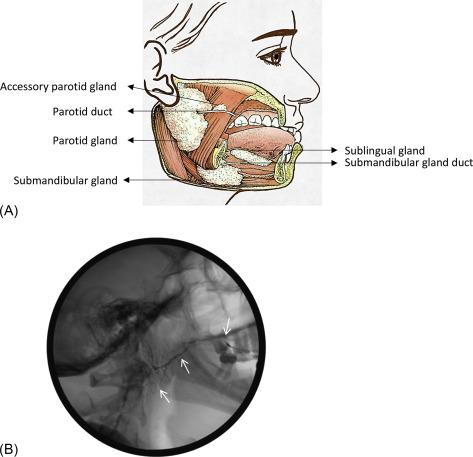
The SMG is the second largest major salivary gland, weighing 7–16 g and located in the submandibular triangle, bounded superiorly by the inferior edge of the mandible and inferiorly by the anterior and posterior bellies of the digastric muscle ( Fig. 37.1 ). The SMG has both mucous and serous cells that empty into ductules, which in turn empty into the submandibular duct. The submandibular ducts or Wharton’s ducts emerge anteriorly and course deep to the lingual nerve and medial to the SLG until each duct opens lateral to the lingual frenulum in the floor of the mouth behind the lower incisor tooth. SMGs comprise a mixture of mucous and serous components. Although the serous acini predominate, the proportion of both components may vary among lobes. SMG saliva is viscous and rich in glycoproteins, sulfated cystatins and neuronal and epidermal growth factors.
The smallest of the major salivary glands is the SLG, weighing 2–4 g and consisting of mucous acinar cells. The SLG lies flat within the anterior floor of the mouth, superior to the mylohyoid muscle ( Fig. 37.1 ). Unlike the other major glands, the SLG lacks a true fascial capsule, which is instead covered by oral mucosa on its superior aspect. Several ducts (of Rivinus) from the superior portion of the SLG either secrete directly into the floor of mouth, via the sublingual caruncles, or empty into Bartholin’s duct that then continues into Wharton’s duct.
The exocrine salivary glands secrete saliva from a flask-like, blind-ended secretory structure called the salivary acinus. Salivary acini are divided into three main types: serous, mucous, and mixed that convey their isotonic secretion into a network of intralobular (intercalated and striated) and interlobular (excretory) ducts ( Fig. 37.2 ).
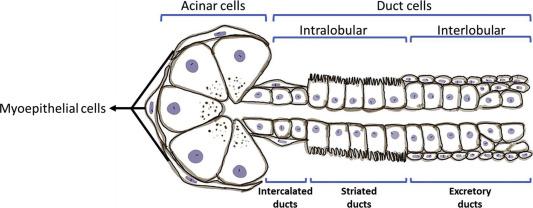
The PG is predominantly made up of serous acini that comprise 8–12 pyramidal-like cells. Parotid acinar cells are surrounded by a distinct basement membrane and contain abundant cytoplasmic granules (zymogen granules) ( Fig. 37.3 ).
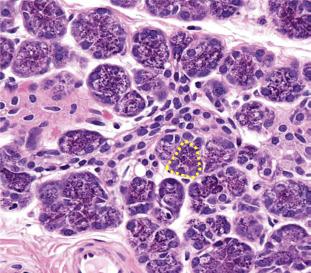
The SMG is classified as a mixed gland that is predominantly serous with tubular acini, which display a very granular eosinophilic cytoplasm. Only approximately 10% of the acini are mucinous, with large, triangular acinar cells containing central nuclei and clear cytoplasmic mucin vacuoles ranging in size. The mucinous cells are capped by demilunes, which are crescent-shaped formations of serous cells ( Fig. 37.4 A ). The intercalated ducts of the SMG are longer than those of the PG, while the striated ducts are shorter. In rodents, the SMGs comprise serous acini solely and the male glands contain high-columnar granular convoluted tubules detected between intercalated and striated ducts ( Fig. 37.4 B).
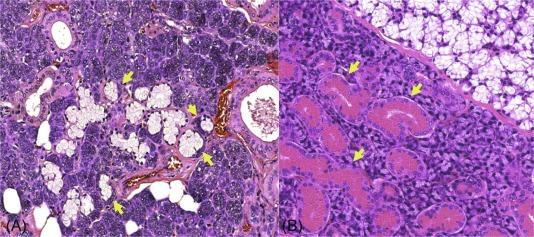
Like the SMG, the SLG has mixed acini with observable serous demilunes within the glandular tissue ( Fig. 37.5 ). Unlike the SMG, the SLG is predominantly mucinous.
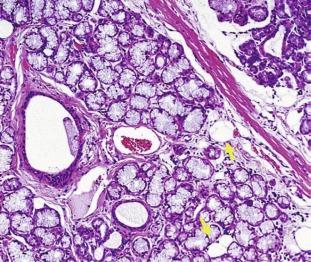
Become a Clinical Tree membership for Full access and enjoy Unlimited articles
If you are a member. Log in here